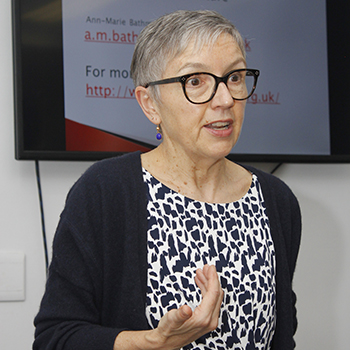
Prof Ann-Marie Bathmaker, University of Birmingham,
during her presentation at the UFS.
Photo: Eugene Seegers
Paired Peers: Pathways to social mobility—Investing in the future? Moving through HE and into employment was recently presented to staff and postdoctoral students by Prof Ann-Marie Bathmaker, from the University of Birmingham, during her visit to South Africa while working on the Miratho Research Project with CRHED. Prof Bathmaker’s research interest particularly focuses on issues of equity, social mobility, and social class inequalities. Her presentation, the second in the Higher Education Research Seminar series presented by CRHED, was based on research resulting from a seven-year project in England.
In the UK, higher education (HE) is considered a key route to social mobility. Interest has grown in graduate destinations, particularly the prospects and obstacles faced by graduates from different social backgrounds. Paired Peers followed 70 students throughout their undergraduate studies and into the working world.
The project explored the processes of social mobility, highlighting different orientations and practices towards investing in the future, which ranged from investing in the present to cultural entrepreneurship for the future.
Participants were selected from two universities in Bristol, England. The research team focused on three key themes: “Getting In” (access to HE), “Getting On” (financial limitations, friendships, accommodation), and “Getting Out” (holiday work, internships, and finding suitable graduate employment).
Prof Bathmaker was able to highlight key research findings, many of which resonated with those attending. From the question-and-answer session, it was clear that many issues regarding inclusivity, whether across gender, ethnic, or language barriers, find their parallels in the South African context and can be of benefit to higher education practitioners here.